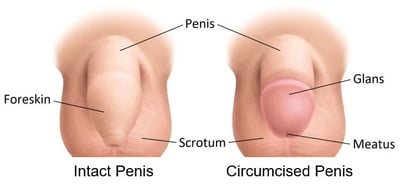What is a circumcision?
Circumcision is an optional surgery that removes the foreskin from the penis. The foreskin is a natural fold of skin that protects the glans (head) of the penis. The foreskin is the most sensitive part of the penis. It also helps reduce friction during sex by gliding. For some families, circumcision is an important religious practice.
How is a circumcision done?
Circumcision takes about 20 minutes to do. A provider will describe how pain is reduced during the surgery. Your child will first be placed in a restraint to help keep still. The foreskin will be separated from the glans. It will then be removed with a clamp and scalpel. Lastly, the penis will be covered with protective gauze. Care instructions will be given to you by your provider.What if my child does not get circumcised?
Parents can choose to leave their child intact (not circumcised). In America, about half of children will grow up with an intact penis. This option supports the natural development of your child. It also allows them to personally make this decision when older. The intact penis needs no special care. Good hygiene is easy whether intact or circumcised. A circumcision is rarely needed for health reasons.What are the benefits of circumcision?
• Urinary Tract Infection (UTI): UTIs are rare in males. Circumcision lowers the chance of getting a UTI by 1%. UTIs usually quickly get better with medicine. Staying hydrated and good hygiene prevents most UTIs.• Phimosis: About 1% of foreskins get too tight. Skin creams often fix this, but sometimes a circumcision is needed. Not forcibly pulling on a child’s foreskin helps prevent phimosis.
• Sexually Transmitted Disease (STD): Some STDs may be slightly less likely if circumcised. Safe sex practices, like using condoms and getting vaccinated, are the best way to avoid STDs.
What are the risks of circumcision?
• Pain: Pain medicine is given during the surgery. Moderate pain can still happen.• Bleeding & Infection: There will be slight bleeding that is usually easily controlled. Sometimes there is too much bleeding or in rare cases, an infection that needs treatment.
• Meatal Stenosis: Irritation from diapers can cause the meatus (pee opening) to get too small. About 15% of circumcised children are affected. This can make it hard to pee. Surgery may be needed to fix it.
• Sensitivity & Function: Removing the foreskin changes penis sensitivity and causes more friction during sex.
• Asymmetry: Sometimes too much or an uneven amount of foreskin is removed. This can cause tight erections. About 1% of children have a repeat circumcision to remove more skin. The healing skin can also stick to the glans of the penis.
What do health care professionals say about circumcision?
The American Academy of Pediatrics has said the health benefits are not great enough to recommend the circumcision of all newborns. Most medical organizations agree that there are no clear medical reasons to circumcise healthy children.Parents should weigh these views along with the risks and benefits of circumcision. Talk with your health care provider to help you decide what is best for your child.
For other health and wellness information, check out this resource: https://kidshealth.org/ChildrensWi/en/parents




